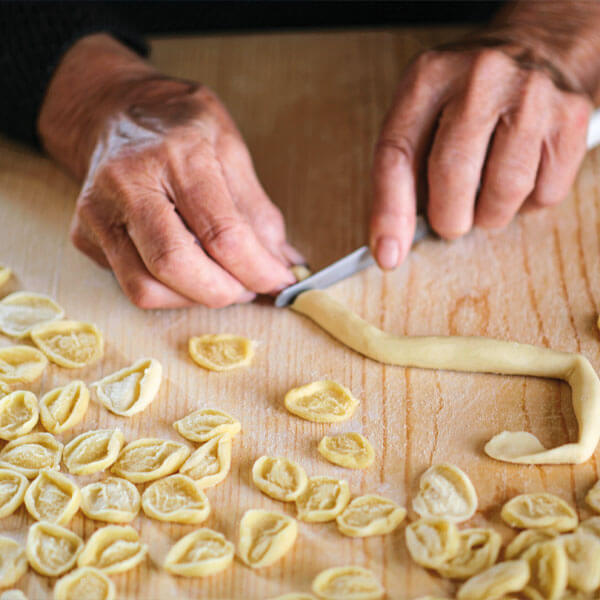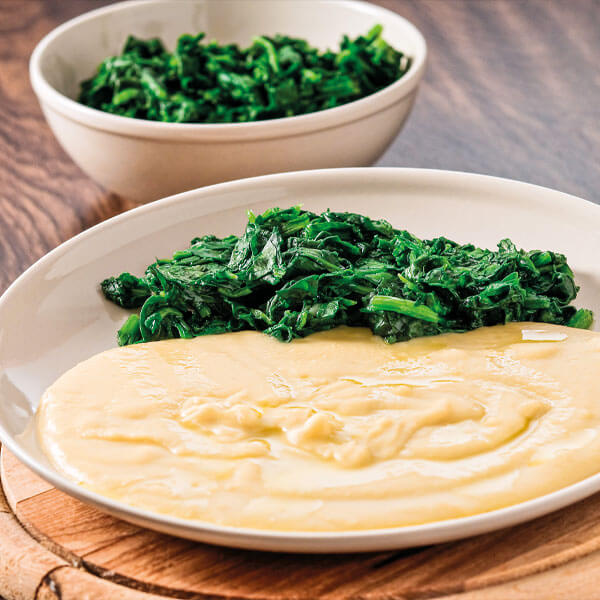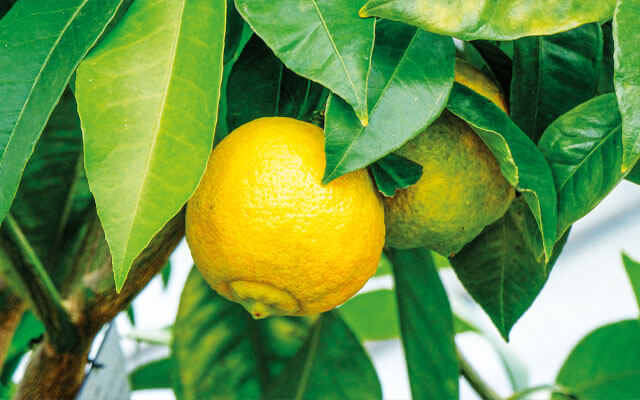Mussels are one of Puglia’s great seafood staples. They’re especially prized in Taranto where they’re famously cultivated in the placid waters of the Mar Piccolo. Hardcore aficionados might eat them raw but most people cook them and they work brilliantly well with spaghetti, black pepper and parsley. In Taranto, the local speciality is tubettini con le cozze, a delicious mix of mini pasta tubes with mussels and sweet tomatoes. In Bari they like their mussels oven-baked with rice and potatoes, a dish known as riso, patate e cozze.
Puglia’s signature pasta is its orecchiette. A classic of the region’s cucina povera, these ‘small ears’ of pasta are made with a bare minimum of ingredients, just durum wheat flour and water, and rolled by hand. They can be served with tomato sauces such as ragù di brasciole, a rich slow-cooked meat sauce prepared with veal rolls, but they’re most famously partnered with cime di rapa (turnip tops). Another famous pasta, typical of the Salento area, is sagne ncannulate. These rolled ribbons of pasta are traditionally served with tomato sauce and a topping of salted cacioricotta cheese.

The skillful use of humble greens has long been a hallmark of Pugliese cuisine. Turnip tops are served with orecchiette, and chicory, which flourishes in the Salento area, features in one of the region’s oldest signature dishes – capriata pugliese. This is a simple combo of chicory with a purèe of fava beans, crowned by a generous drizzle of extra-virgin olive oil. Fava beans are grown across the region, from the Gargano, where Carpino’s beans are recognized as a Slow Food speciality, to the dry fields of the Salento. Their creaminess combines with the slight bitterness of the chicory and olive oil to produce a tasty and surprisingly complex blend of flavours.

With its roots in Puglia’s cucina povera and Arab-inflected history, ciceri e tria is a pasta speciality of the Salento. It’s a flavoursome and typically simple dish which combines chickpeas with strips of pasta, some of which has been fried to provide a crunchy texture. There are several versions which include breadcrumbs or fried bread, or mix in salted anchovies.
One of the Salento’s most quintessential staples are its frise. Known also as friselle or, in the local dialect, friseddhe, these are rusks of dried, twice-baked bread. To eat, they are first softened in water and then dressed, typically with sweet cherry tomatoes, a drop of extra-virgin olive oil and a dash of oregano. Tuna, mixed with cucumber and chili pepper, is another favourite topping. In the past, they provided labourers and fishermen with a nutritious, easy-to-carry meal. Nowadays, they are popular as an aperitivo snack or a quick summer lunch.

Puglia’s cheeseboard is rich and varied, ranging from pear-shaped caciocavallo podolico and its spicy relative pallone di Gravina to flaky cacioricotta and delicate, cow’s milk mozzarella. Particularly prized are the cheeses prepared with stretched curd (pasta filata), such as mozzarella, stracciatella and burrata. To learn more about the age-old techniques used by the region’s cheesemakers, search out a caseificio (dairy). Alternatively, stop by one of the many family-friendly masserie didattiche (educational farms) dotted across the region.

Even Italian speakers need a dictionary to navigate Puglia’s vast dessert menu. Every city, town and village seems to have its own sweets and pastries, often named in the local dialect, and every festival demands a specific dolce. Pettole, deep-fried dough balls, are a Christmas favourite, as are cartellate, shallow crowns of pastry which are fried or baked and sweetened with honey or vincotto (cooked red-grape must). Scarcella is an Easter treat, a sweet biscuit decorated with an egg. Then you have sospiri, mounds of sugar-glazed sponge cake filled with vanilla-infused cream, from Bisceglie, and sporcamuss from Bari. Meaning ‘dirty your mouth’ in the local dialect, these are small puff pastries filled with custard and sprinkled with icing sugar.
Several of Puglia’s regional products are recognised by the Slow Food organisation and/or carry a protected designation of origin.
Gargano Citrus Fruits Oranges and lemons thrive in the Gargano, the only place on Puglia’s Adriatic coast where citrus fruits are cultivated.
Clementines from the Gulf of Taranto A cross between an orange and a mandarin, clementines are grown in the fields and rocky canyons of Palagiano, Massafra, Ginosa, Castellaneta, Palagianello and Statte.
Almonds Almonds flavour many Pugliese sweets and pastries. Particularly prized are the almonds from Toritto.
Tomatoes Important varieties include small, sweet Fiaschetto di Torre Guaceto tomatoes, good for sauces; the yellowish-orange Giallorosso di Crispiano tomatoes; and Manduria’s sweet cherry tomatoes, traditionally eaten raw.
Figs from Fasano The area around Fasano and Torre Canne is known for its fioroni, large figs that are delicious eaten raw or as a gelato flavour.


BuyPuglia is the digital system tailored to suit your tourism business in Puglia. Our matching platform is an easy tool to explore meeting opportunities with Puglian suppliers and learn about their tourism &.. cultural products. BuyPuglia ranks buyers and sellers based on entered information. Shared interests are paired, helping plan effective meetings and delivering optimized supply &.. demand solutions.